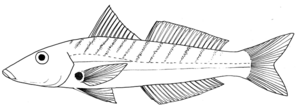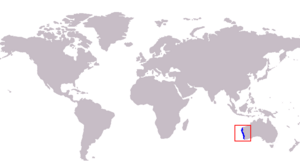Western school whiting facts for kids
Quick facts for kids Western school whiting |
|
|---|---|
 |
|
| Scientific classification | |
 |
|
| Range of the western school whiting |
The western school whiting (Sillago vittata) is a type of fish that lives on the ocean floor. It's also known by other names like the banded whiting, golden whiting, and sometimes even bastard whiting. This fish belongs to the smelt-whiting family, called Sillaginidae.
The western school whiting looks very similar to two other "school whiting" species found in southern Australia. These fish can grow up to 30 centimeters (about 12 inches) long and weigh around 275 grams (about half a pound). You can find them along the coast of Western Australia, from Maud Landing in the north down to Rottnest Island in the south. They live in both shallow waters near the shore and deeper waters, up to 55 meters (about 180 feet) deep.
This whiting is a predator that hunts for food on the seabed. It eats different kinds of crustaceans (like crabs and shrimp), molluscs (like snails and clams), and echinoderms (like sea stars). What they eat can change as they get older and depending on where they live. Western school whiting lay their eggs in batches between December and February, usually when they are one or two years old. Young fish stay in safe, shallow waters near the coast. Once they are old enough to have babies, they move to deeper waters. This fish is sometimes caught by fishermen in Western Australia, but not as much as other types of whiting.
Contents
About the Western School Whiting
The western school whiting is one of 29 different kinds of fish in the Sillago group. This group is part of the smelt-whiting family, Sillaginidae. These fish are also part of a larger group called Perciformes.
Scientists first officially described the western school whiting in 1985. A scientist named Roland McKay was the first to realize it was a different species from the Sillago bassensis. He studied a fish caught near Rottnest Island to name and describe the species. In Australia, it's often called 'western school whiting', which can sometimes be confusing because another fish used to have that name. Its scientific name, vittata, comes from a Latin word meaning 'banded', which refers to the stripes on its body.
What Does It Look Like?
The western school whiting looks a lot like other whiting species that live in the same areas. The best ways to tell them apart are by their colors and the shape of their swimbladder (an air-filled sac that helps them float). As mentioned, they can grow up to 30 cm long and weigh 275 g. However, some people have reported seeing much larger ones in Shark Bay.
Like all whiting, they have a fairly flat underside and a slightly curved back. Their back fin is split into two parts. The first part has 11 sharp spines, and the second, longer part has one spine and 17 to 19 soft rays. The fin on their belly has two spines and 16 to 18 soft rays. Their bodies are covered in special scales called ctenoid scales, except for some scales on their cheeks. They have about 65 to 70 scales along their lateral line (a special line of sensors on their side) and 32 to 34 vertebrae (backbones).
The swimbladder of the western school whiting is very similar to that of S. bassensis and S. robusta. It has a short projection at the back and a small tube that connects to its underside.
Color and Markings
The head and upper body of the western school whiting are tan (light brown). This color fades to a paler shade below, with a shiny white belly. When they are alive, you might see blue, purple, and yellow colors reflecting off their bodies. Some very large fish seen in Shark Bay were golden yellow all over, but they still had the special stripes that give them their name.
They have 8 to 11 rusty brown to dark brown stripes that run diagonally down their sides. These stripes often cross over a clear, silvery-white band that runs along the side of the fish. This band starts behind their gill cover and goes all the way to the base of their tail fin. The first part of their back fin is whitish at the bottom and yellow at the top, with brown spots. The second back fin is white at the base and lemon yellow at the top, with three rows of black spots that form lines across the fin. Their anal fin (on the belly) is bright yellow with white edges. Their belly fins are pale yellow with white edges, and their tail fin is yellow. The pectoral fin (behind the gills) is pale lemon yellow or clear, with a large, dark brown or bluish-brown spot right at its base.
Where They Live and Their Home
The western school whiting is only found along the coast of Western Australia. Its known range stretches from Maud Landing in the north to Rottnest Island, near Perth, in the south. There have been reports of a "narrow-barred whiting" near Fremantle that might also be this species, which would mean they live even further south.
These fish live in both shallow waters close to the shore and deeper waters on the continental shelf, up to 55 meters deep. In shallower areas, they can be found among seagrass beds, coral reefs, and sandy areas, including beaches. They often mix with other types of whiting. Studies in Western Australia found that these fish are most common between 5 and 15 meters deep. This is because young fish need to move to deeper areas as they grow up.
How They Live
Scientists from Murdoch University and the Western Australian Marine Research Laboratories have studied the western school whiting quite a bit. As their name suggests, western school whiting often swim together in groups, or "schools." They sometimes join schools with other whiting species. In shallow waters, they might be found with Sillago burrus, Sillago schomburgkii, and Sillago analis. In deeper offshore waters, they are often seen with Sillago robusta, Sillago bassensis, and Sillago burrus.
Diet and Feeding Habits
The western school whiting is a predator that hunts for food on the ocean floor. They eat many different things, including polychaete worms, small crustaceans like copepods and amphipods, molluscs, and ophiuroid echinoderms (like brittle stars). They also sometimes eat other fish.
Studies show that what they eat can change depending on where they live and the time of year. The type of habitat they are in has the biggest effect on their diet. Their age also plays a role. As they get bigger, they tend to eat a wider variety of prey. Younger fish often focus on one specific type of food. Generally, young whiting eat more copepods, while adult whiting eat more amphipods and polychaete worms. Larger fish are the only ones that eat other fish.
Western school whiting often eat similar foods as other whiting species that live in the same areas. Young fish in shallow, protected places might compete for food with young S. burrus, S. schomburgkii, and Sillaginodes punctatus because they all like to eat copepods. However, they lay their eggs at different times, which helps reduce this competition.
Like other whiting, they have special mouths that can extend forward like a tube. This helps them suck up a wide range of prey from the sand and mud. Their mouths can extend further down than other whiting species, which might explain why they eat more polychaete worms.
Reproduction and Life Cycle
Western school whiting in deeper waters can start having babies (reach sexual maturity) by the end of their first year. However, those living closer to shore don't fully mature until the end of their second year. All male fish are ready to reproduce when they are about 130 mm long, and females are ready when they are about 160 mm long.
These fish lay their eggs in deeper waters between December and February, with the busiest time being early January. They are "batch spawners," meaning they release their eggs in several batches over a period of time during these months. This might help them deal with bad environmental conditions. Young whiting live in safe, shallow waters like bays and mangrove swamps until they are old enough to reproduce. Then, they move offshore to lay their eggs. Western school whiting usually live for about 2 years, but some can live up to 7 years. This means they can have babies multiple times throughout their lives.
Western School Whiting and People
Compared to other whiting species in Western Australia, not many western school whiting are caught. However, there are a few small fisheries (places where fish are caught for sale) that target them. One is near Rottnest Island, where they are caught using trawl nets in deeper offshore waters. Another is in Shark Bay, where they are part of the whiting catch. In Shark Bay, they can make up to 20% of all the whiting caught. Fishermen sometimes call them 'bastard whiting' because if they catch a lot of S. vittata, it means they are catching fewer of the fish they really want. Overall, the western school whiting is not a huge part of the fishing industry in Western Australia.
Even though professional fishermen might not always want to catch them, western school whiting are considered to have very good flesh for eating. They can sell for similar high prices at the market as other whiting species. In the southern part of Western Australia, they usually live in deeper waters, so recreational fishermen (people who fish for fun) don't catch them very often. In the northern part of their range, where they live in shallower waters, anglers often look for bigger tropical fish instead. So, they are not a major fish for recreational fishing either.
If you do want to catch them, they respond to the same fishing styles as other whiting. This usually means using light lines and sinkers with worm or mollusc baits. They can be caught off beaches, jetties, and from boats. There is no minimum size for catching them, but there is a daily limit of 40 fish per person.
Images for kids
See also
 In Spanish: Sillago vittata para niños
In Spanish: Sillago vittata para niños


